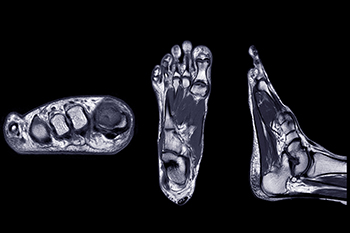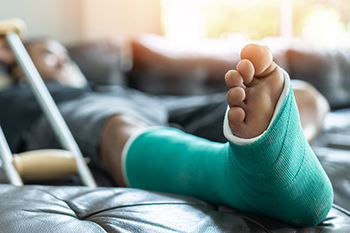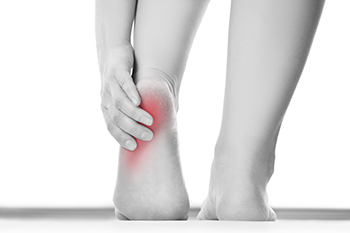Connect With Us
Blog
Items filtered by date: November 2022
Foot Pain May Indicate Medical Issues Within the Body

When people have foot pain, they may be unaware it may be indicative of other existing issues in the body. Pain in the big toe may be the first sign of hammertoe, arthritis, gout, or an ingrown toenail. Some patients experience pain in the ball of their foot that may be a symptom of Morton’s neuroma, which affects the nerves between the third and fourth toes. Additionally, it can also happen as a result of overuse injuries where the muscles have become tense. Swelling, pain and stiffness in the front of the foot may be a symptom of the rare foot condition that is known as Freiberg’s disease. Surgery may be a necessary treatment option if the prescribed medication fails to work. Pain that develops in the arch of the foot may be a sign of flat feet, plantar fasciitis, or a possible Achilles tendon injury. If you have foot pain for any reason, a podiatrist is the type of doctor to visit who can determine if the pain indicates there may be a medical issue within the body.
When dealing with systemic disease of the feet, it is extremely important to check the affected areas routinely so that any additional problems are caught quickly. If you have any concerns about your feet and ankles contact Imaze Marian Davis, DPM from Marian Davis, DPM, PA. Our doctors will assist you with all of your podiatric needs.
Systemic Diseases of the Feet
Systemic diseases affect the whole body, and symptoms usually are displayed in the feet. This condition can make a patient’s ability to walk unbearable. Systemic diseases include gout, diabetes mellitus, neurological disorders, and arthritis.
Gout – is caused by an excess of uric acid in the body. Common symptoms include pain, inflammation, and redness at the metatarsal/phalangeal joint of the base big toe. Gout can be treated by NSAIDs to relieve pain and inflammation, and other drugs that lower the acid levels in the body.
Diabetes mellitus – is an increase in the level of blood sugar that the body cannot counteract with its own insulin. Failure to produce enough insulin is a factor in Diabetes.
Diabetes of the Feet
Diabetic Neuropathy – may lead to damaged nerves and affect the feet through numbness and loss of sensation.
Peripheral Vascular Disease – can restrict the blood flow to the feet, and often times lead to amputation of the feet.
If you have any questions please feel free to contact our office located in Miami, FL . We offer the newest diagnostic and treatment technologies for all your foot and ankle needs.
What to Expect From a Broken Foot

Yearly, foot fractures affect millions of people worldwide. Each foot has 26 bones, numerous tendons, joints, and muscles, and there are risks that a foot fracture can occur from an injury. The biggest bone in the foot is called the calcaneus. The bone located on the top of the foot is known as the talus. The metatarsals are in the forefoot, in addition to several bones that are in each toe. Any one of these bones can break due to a fall or if something heavy drops on them. In severe breaks, a bone can protrude from the skin and this can make the foot appear deformed. Surgery is often necessary to move the bone back in place and healing can take several weeks. The majority of broken feet are treated by using a walking cast or a boot. The cast can often provide the support that is necessary as the healing process occurs. If you have broken your foot, it is strongly suggested that you confer with a podiatrist who can provide the best treatment options for you.
A broken foot requires immediate medical attention and treatment. If you need your feet checked, contact Imaze Marian Davis, DPM from Marian Davis, DPM, PA. Our doctors can provide the care you need to keep you pain-free and on your feet.
Broken Foot Causes, Symptoms, and Treatment
A broken foot is caused by one of the bones in the foot typically breaking when bended, crushed, or stretched beyond its natural capabilities. Usually the location of the fracture indicates how the break occurred, whether it was through an object, fall, or any other type of injury.
Common Symptoms of Broken Feet:
- Bruising
- Pain
- Redness
- Swelling
- Blue in color
- Numbness
- Cold
- Misshapen
- Cuts
- Deformities
Those that suspect they have a broken foot shoot seek urgent medical attention where a medical professional could diagnose the severity.
Treatment for broken bones varies depending on the cause, severity and location. Some will require the use of splints, casts or crutches while others could even involve surgery to repair the broken bones. Personal care includes the use of ice and keeping the foot stabilized and elevated.
If you have any questions please feel free to contact our office located in Miami, FL . We offer the newest diagnostic and treatment technologies for all your foot and ankle needs.
Bodyboarding and Foot Pain

Many beachgoers like to spend their time in the ocean, catching waves in an activity that is known as bodyboarding. When an individual goes bodyboarding, they sometimes use bodyboarding fins (or flippers) on their feet to help with swimming. However, wearing these flippers can sometimes negatively impact the feet. For example, if the flippers are particularly low quality, they can easily rub up against the feet, causing friction that might lead to the development of blisters. This chaffing can be quite uncomfortable for your feet. If you are a bodyboarder and you want to wear flippers, contact your podiatrist to ensure that you are doing everything that you can to properly protect your feet.
Sports related foot and ankle injuries require proper treatment before players can go back to their regular routines. For more information, contact Imaze Marian Davis, DPM of Marian Davis, DPM, PA. Our doctors can provide the care you need to keep you pain-free and on your feet.
Sports Related Foot and Ankle Injuries
Foot and ankle injuries are a common occurrence when it comes to athletes of any sport. While many athletes dismiss the initial aches and pains, the truth is that ignoring potential foot and ankle injuries can lead to serious problems. As athletes continue to place pressure and strain the area further, a mild injury can turn into something as serious as a rupture and may lead to a permanent disability. There are many factors that contribute to sports related foot and ankle injuries, which include failure to warm up properly, not providing support or wearing bad footwear. Common injuries and conditions athletes face, including:
- Plantar Fasciitis
- Plantar Fasciosis
- Achilles Tendinitis
- Achilles Tendon Rupture
- Ankle Sprains
Sports related injuries are commonly treated using the RICE method. This includes rest, applying ice to the injured area, compression and elevating the ankle. More serious sprains and injuries may require surgery, which could include arthroscopic and reconstructive surgery. Rehabilitation and therapy may also be required in order to get any recovering athlete to become fully functional again. Any unusual aches and pains an athlete sustains must be evaluated by a licensed, reputable medical professional.
If you have any questions please feel free to contact our office located in Miami, FL . We offer the newest diagnostic and treatment technologies for all your foot and ankle needs.
Common Causes of Heel Pain

Heel pain takes many forms, but its main cause is overuse from repetitive activity. The most common forms of heel pain are plantar fasciitis, Achilles tendonitis, and arthritis. If you experience sudden or severe heel pain from an accident or injury, it is recommended to see a podiatrist immediately. Other causes of heel pain include blisters, corns, bursitis, and stress fractures. One way to prevent heel pain is by reducing the stress on the feet when exercising. It is a good idea to stretch and do warm-up exercises before engaging in vigorous activities that can put stress on the heel. Ignoring heel pain is not a good idea, because it can lead to overcompensation and changes of gait. This may then begin to affect other body parts and lead to even more serious problems. If you are experiencing heel pain on a regular basis, or for longer periods of time, please visit a podiatrist for a thorough examination.
Many people suffer from bouts of heel pain. For more information, contact Imaze Marian Davis, DPM of Marian Davis, DPM, PA. Our doctors can provide the care you need to keep you pain-free and on your feet.
Causes of Heel Pain
Heel pain is often associated with plantar fasciitis. The plantar fascia is a band of tissues that extends along the bottom of the foot. A rip or tear in this ligament can cause inflammation of the tissue.
Achilles tendonitis is another cause of heel pain. Inflammation of the Achilles tendon will cause pain from fractures and muscle tearing. Lack of flexibility is also another symptom.
Heel spurs are another cause of pain. When the tissues of the plantar fascia undergo a great deal of stress, it can lead to ligament separation from the heel bone, causing heel spurs.
Why Might Heel Pain Occur?
- Wearing ill-fitting shoes
- Wearing non-supportive shoes
- Weight change
- Excessive running
Treatments
Heel pain should be treated as soon as possible for immediate results. Keeping your feet in a stress-free environment will help. If you suffer from Achilles tendonitis or plantar fasciitis, applying ice will reduce the swelling. Stretching before an exercise like running will help the muscles. Using all these tips will help make heel pain a condition of the past.
If you have any questions please contact our office located in Miami, FL . We offer the newest diagnostic and treatment technologies for all your foot and ankle needs.
Heel Pain Can Be Treated!
How Does the Cuboid Bone Work?

The feet are incredibly complex, intricate parts of the human body, made up of a number of different and important bones. Each bone serves a critical function, including the cuboid bone. One ought to know about this bone because it serves an important role in supporting the arch of the foot and providing stability. As the name of the bone suggests, it is shaped in a kind of cubical structure. This bone is located in the midfoot area and is situated essentially on the outer side of the foot. Being diligent in taking good care of the cuboid bone is essential to maintaining good foot health because if it moves out of alignment, a condition known as cuboid syndrome might develop. This foot affliction can cause a variety of symptoms, most notably a kind of pain on the outer side of the foot. This area of the foot is commonly referred to as the lateral area. For more information about this important bone in the foot, contact your podiatrist.
If you have any concerns about your feet, contact Imaze Marian Davis, DPM from Marian Davis, DPM, PA. Our doctors can provide the care you need to keep you pain-free and on your feet.
Biomechanics in Podiatry
Podiatric biomechanics is a particular sector of specialty podiatry with licensed practitioners who are trained to diagnose and treat conditions affecting the foot, ankle and lower leg. Biomechanics deals with the forces that act against the body, causing an interference with the biological structures. It focuses on the movement of the ankle, the foot and the forces that interact with them.
A History of Biomechanics
- Biomechanics dates back to the BC era in Egypt where evidence of professional foot care has been recorded.
- In 1974, biomechanics gained a higher profile from the studies of Merton Root, who claimed that by changing or controlling the forces between the ankle and the foot, corrections or conditions could be implemented to gain strength and coordination in the area.
Modern technological improvements are based on past theories and therapeutic processes that provide a better understanding of podiatric concepts for biomechanics. Computers can provide accurate information about the forces and patterns of the feet and lower legs.
Understanding biomechanics of the feet can help improve and eliminate pain, stopping further stress to the foot.
If you have any questions please feel free to contact our office located in Miami, FL . We offer the newest diagnostic and treatment technologies for all your foot and ankle needs.


